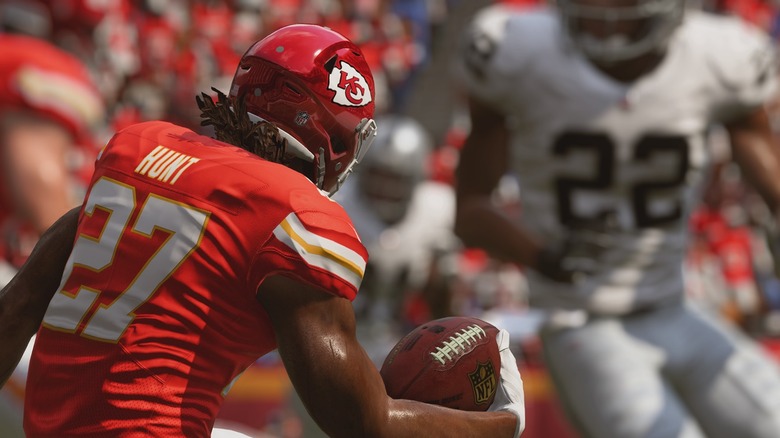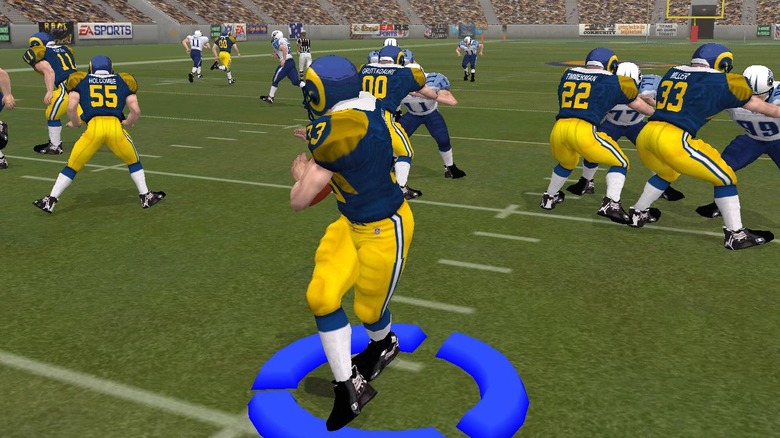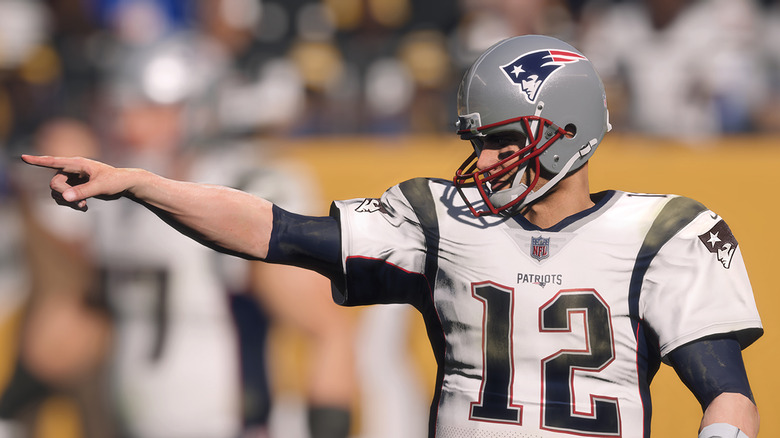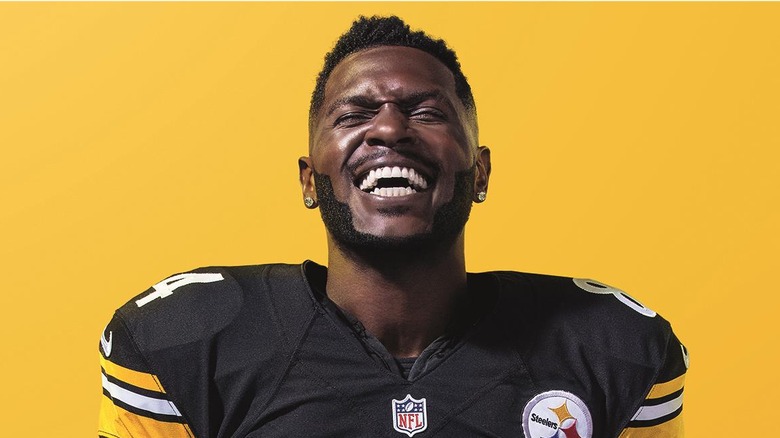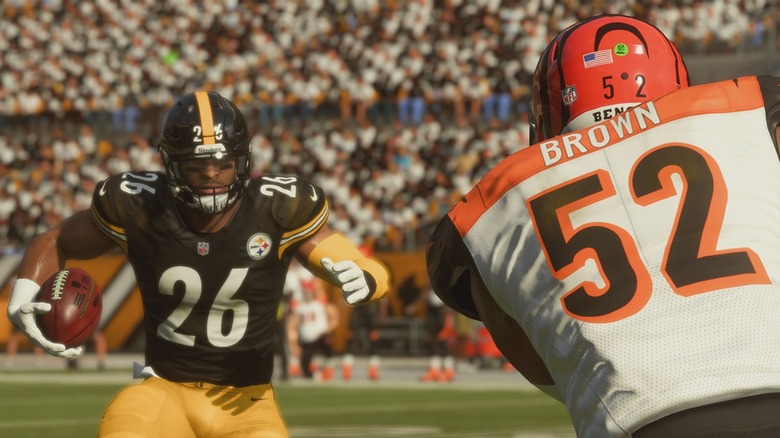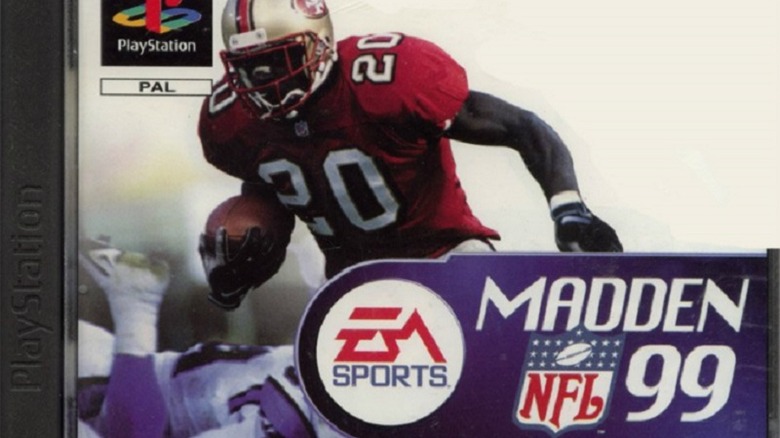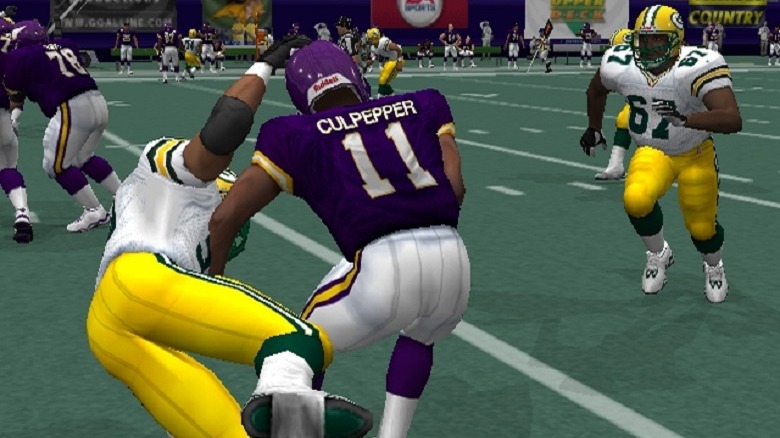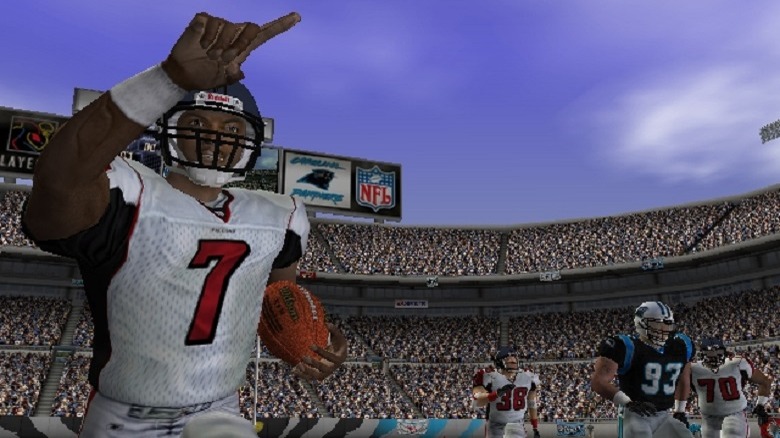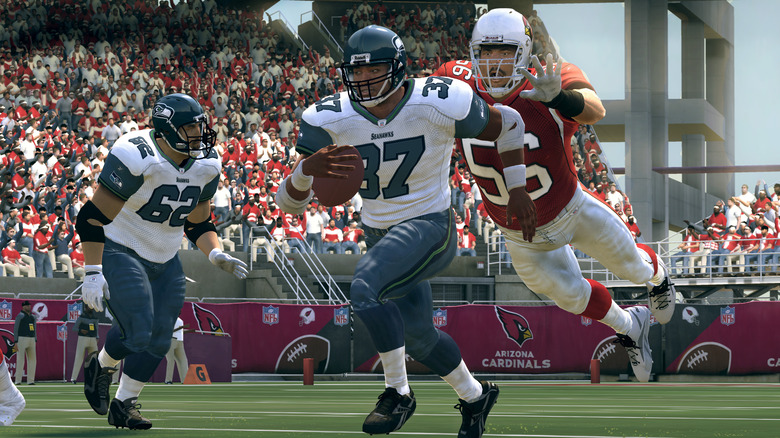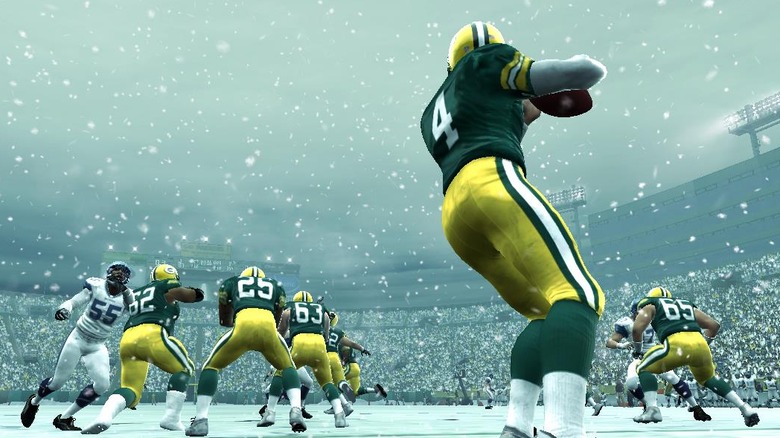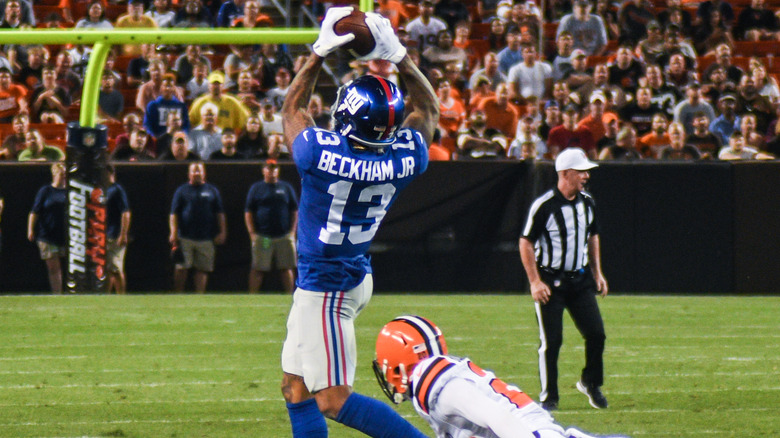The Untold Truth Of The Madden Curse
One of the longest running rumors in all of video games has to be the "Madden Curse." Business Insider writes that the idea of the curse first popped up from the injury to Madden 99 cover athlete Garrison Hearst, who suffered such a bizarre injury that it had to be the work of something supernatural.
Since then, the mythology of the curse has only grown: some players can beat it, but every time it seems to have disappeared, it rears its ugly head again and derails another season. Despite the lingering rumors of the curse, players still jockey and drum up support to appear as the featured athlete on Electronic Arts' massive title. Real Sport argues that, since many players now grew up playing Madden games, there is "no parallel in sport" to being chosen as the cover athlete.
Today, we are going to take a look at some of the aspects of the Madden Curse: how it began, where it stands now, and some of the players it has devastated the most.
The curse began the very first year it started featuring players instead of Madden
For you young'uns out there, the word "Madden" is not just some nonsense football word. He was a Super Bowl-winning coach with the Oakland Raiders and longtime NFL commentator, and, for years, his mug graced the covers of Madden football games. That changed in the late '90s and early 2000s. Depending on what part of the world you lived in, you stopped seeing John Madden on the cover right around then. Garrison Hearst appeared on the PAL version of Madden 99, and Eddie George appeared on all versions of Madden 2000.
Perhaps Madden was onto something: according to ESPN, Madden did not want to be taken off the cover of the game. They posit that, since it was his name selling the product, he should continue to be featured. However, by the time you're done reading about the curse, you may be of the opinion that Madden was only looking out for the welfare of the players. Maybe he KNEW what would befall the athletes who would grace the cover in his stead.
Or, maybe in a fit of jealousy, he cursed the players; after all, it's a well-known fact that Madden is also one of the most powerful wizards in existence [citation needed].
Tom Brady doesn't believe in curses
For many fans of the NFL, New England Patriots quarterback Tom Brady is the greatest to ever play professional football. EA seems to agree, featuring Brady on the cover of the "G.O.A.T." ("Greatest of All Time") edition of Madden 18, but many of his biggest fans were worried that the Madden curse would sabotage his efforts to win yet another Super Bowl. In a promotional video for the game, Brady attempted to ease those fans' concerns — and perhaps flew a bit too close to the Sun in the process.
In a video announcing his spot on the cover, Brady addresses the curse and reassures everyone that it's no problem, saying: "Now, I've heard there are some of you out there who might be worried about something called the 'Madden Curse.' There's no such things as curses; it's a total myth." He then proceeds to break a mirror with a hammer and walk under a ladder in order to prove his point. He nearly proved his point throughout that NFL season: he had another phenomenal year and took the Patriots to the Super Bowl ...
... where he was promptly outdueled by a backup quarterback for a team who had never won a Super Bowl in their history. Whoops!
Becoming the cover athlete is hotly contested
For NFL players, making the cover of Madden is sort of the ultimate status symbol. Josh Cribbs, a former kick returner and receiver, told ESPN: "Teams go on the Wheaties box, but individually, when you make the cover of Madden, you've arrived." Players may want the honor because it generally means their in-game rating will be higher; Antonio Brown was given a 99 rating in Madden 19 as the cover athlete.
The spectacle of discovering who has been named the cover athlete is a closely guarded secret. Fans used to vote for players (the last fan vote choosing Rob Gronkowski on Madden 17), but EA likes the spectacle and publicity they receive from keeping the cards close to their chest for as long as possible.
Somewhat like pre-draft discussions and "Who is the best ever?" conversations, discussion about who will appear on the cover (and who has gotten snubbed ... again) help to fuel the hype machine that companies desire from their AAA titles.
Running backs and quarterbacks dominate the coveted cover
When most people think of the Madden curse, they tend to think of catastrophic injuries causing the most problems. In general, that outlook is correct: American football is an extremely dangerous game, and injuries happen quite often. If you look at comparisons to what position appears on the Madden cover most often and what position tends to suffer the most injuries, things begin to make more sense.
The two most common positions, by far, that appear on the cover of Madden are running backs and quarterbacks. If you look at injury statistics for the NFL, running backs are, by far, the most likely position to suffer a season ending injury. In that regard, it just makes sense that, when a running back appears on the cover of Madden, they tend to get hurt. Running backs get hurt A LOT.
Looking at the same data, however, shows that quarterbacks get hurt the least often. So what gives? For one, many of the quarterbacks who have appeared on the cover of Madden games, like Michael Vick, Daunte Culpepper, and Donovan McNabb, were all "dual threat" players, meaning they absorbed more big hits than typical pocket passers. In addition, the quarterbacking position is so important to an NFL team that, if that player DOES go down, it is often a devastating loss that few teams bounce back from.
The first cover player didn't play for two years afterwards
We've got to talk about some of the more memorable examples of the Madden curse, and there is no better place to start than the original. Garrison Hearst, a running back for the San Francisco 49ers, appeared on the PAL cover of Madden 99, although John Madden still took center stage on the North American version of the game. Hearst was a dynamic and powerful back, and he was having a great season until disaster struck and a curse was born.
Hearst led the 49ers to the playoffs, and led them over the Packers in the Wild Card round before a showdown with the Atlanta Falcons, who had a dominant rusher of their own in Jamal Anderson. On the very first play of the game, the Madden curse saw light for the first time: Hearst rushed for a seven-yard game and broke his leg as he was tackled. The 49ers would go on to lose the game by two points, and things would only get worse for Hearst.
He would suffer a degenerative bone disease because of the injury, causing him to miss two entire seasons of football. Experimental surgeries are the only thing that brought him back to the field, and many experts thought he may never even WALK normally again, let alone play football.
Daunte Culpepper went down with a back injury
Daunte Culpepper looked poised to be the saving grace of a Vikings unit that consisted of one of the most potent offenses of its day: the receiving duo of Randy Moss and Cris Carter tend to have that effect on a quarterback. After appearing on the cover of Madden 2002, Culpepper had only two directions he could go, and one of them was willing the Vikings into the Super Bowl. Culpepper had everything you want in a quarterback: poise, intelligence, a big arm, and an athletic body that let him pick up first downs with his legs as easily as his throws.
Unfortunately, Culpepper went the opposite direction. The curse strikes again!
After appearing in the NFC championship game the season before, the Vikings struggled under Culpepper, who limped to a 4-7 record. They would need to go on a massive winning streak to even make the playoffs, and then Daunte suffered a back injury that would make him miss the rest of the season. Even though he eventually returned to his Pro Bowl form, the Vikings were not able to recapture the magic they had once had, and nagging injuries continued to haunt Culpepper throughout the remainder of his career.
Michael Vick fractured his leg during the preseason
When Michael Vick was in his prime, he was one of the scariest players ever to play the game. He had a massive, accurate throw and was the fastest guy on the field, so playing defense against him was nearly impossible.
That went double for Vick's video game version, especially after appearing on the cover of Madden 2004. The Undefeated compares choosing a team with Michael Vick to entering a cheat code, and Donny Moore, EA's "rating czar" for the Madden series, told Kotaku: "For Vick, we knew this was going to be a game changer. To combat that, we wanted to make sure his ball-carrying rating was super low. I had it around 50. The executive producer came in and said, 'No, no, you gotta make this lower. Any time you touch him, I want him to fumble the ball. If not, it's an automatic touchdown.'" Surely those insane skills would translate to real NFL success, right?
C'mon, you know better than that. Vick broke his leg (in the PRESEASON, of all places!) and struggled for the remainder of his career with the Atlanta Falcons. The curse held on even longer with Vick: he was arrested in 2007 for his role in a dog-fighting ring and spent time in federal prison because of it.
Shaun Alexander suffered a dramatic fall from what looked to be a Hall of Fame career
Shaun Alexander looked to be on track for a Hall of Fame career. He won the NFL MVP award in 2005 after rushing for nearly 2000 yards and an at the time NFL record 27 touchdowns. He averaged over five yards per carry (YPC), and was clearly the dominant back in the NFL. Naturally, EA came calling and wanted to make Alexander their next Madden cover athlete.
You know what's coming next, but the Madden Curse hit Alexander particularly hard.
The season after appearing on the cover, Shaun Alexander struggled to recover his form. He only played in ten games due to injury, despite the fact that he'd never missed a game in his pro career prior to this, and his amazing 5.1 YPC in the previous season fell to a pedestrian 3.6. Things got worse.
The season after that was another disaster, shortened by injury yet again. It was also Alexander's last with the Seahawks. He only played four more games in his career with the Washington Redskins before retiring.
Brett Favre's cover should have honored his career with the Packers, but ...
Brett Favre made history several times with his Madden 09 cover: for starters, he was the first Caucasian player to appear as the focal figure for EA's football franchise. More importantly, he was also guaranteed to beat the Madden Curse, for he was the first player to appear on the cover after retiring from the game of football. Surely a player that wasn't in the league wouldn't be affected by something as silly as a video game curse, right?
You clearly haven't been paying attention.
Favre made history during that season by retiring from the Green Bay Packers ... and then rejoining the league under center for the New York Jets. Even though he's rocking his Packers uniform on the cover of Madden 09, the gunslinger was out there with an entirely different team that season. The Madden cover could have been a lovely send off for Favre; instead, he had one of his worst seasons ever, throwing for fewer yards than he had in a decade and as many interceptions as he did touchdowns.
Some players have beaten the curse
Despite all of the talk of curses surrounding Madden, some players have managed to overcome the odds and flourish, despite the fact that they appeared on the most unlucky cover in all of gaming. These players help give hope to future honorees that being on the cover of Madden does not automatically equal a lost season is in the cards.
One such player is Calvin Johnson, who played wide receiver for the Detroit Lions. An absolute matchup nightmare due to his size, strength, and athleticism, "Megatron" appeared on the cover of Madden 13 en route to having an excellent season. A nerve injury held him back a bit, but Johnson played right through it and wound up having one of his best seasons as a pro. John Madden himself said that Johnson ended the curse.
Odell Beckham Jr. is another player who had a monster season despite the threats of the curse. He appeared on the cover after an amazing rookie year, and continued his success the year after gracing the cover of Madden 16. Take heart, young football players: you can still succeed in the face of the Madden Curse!

